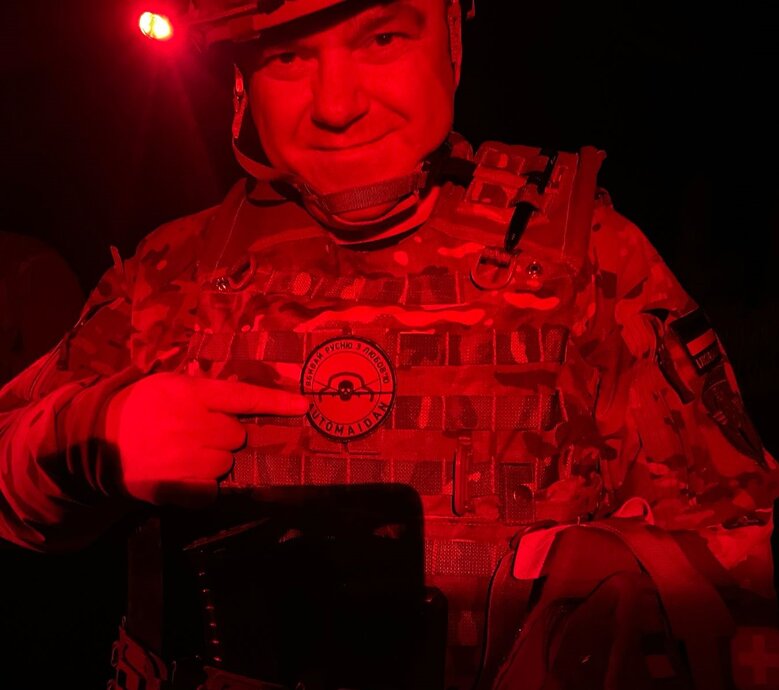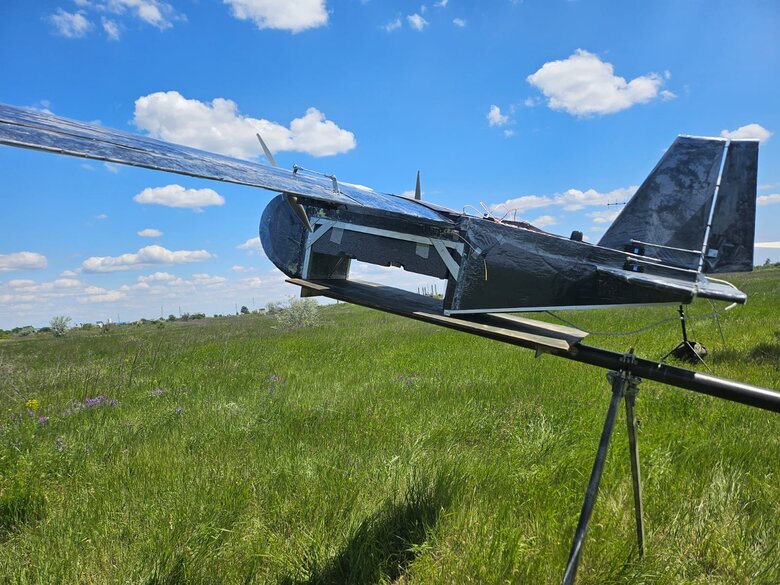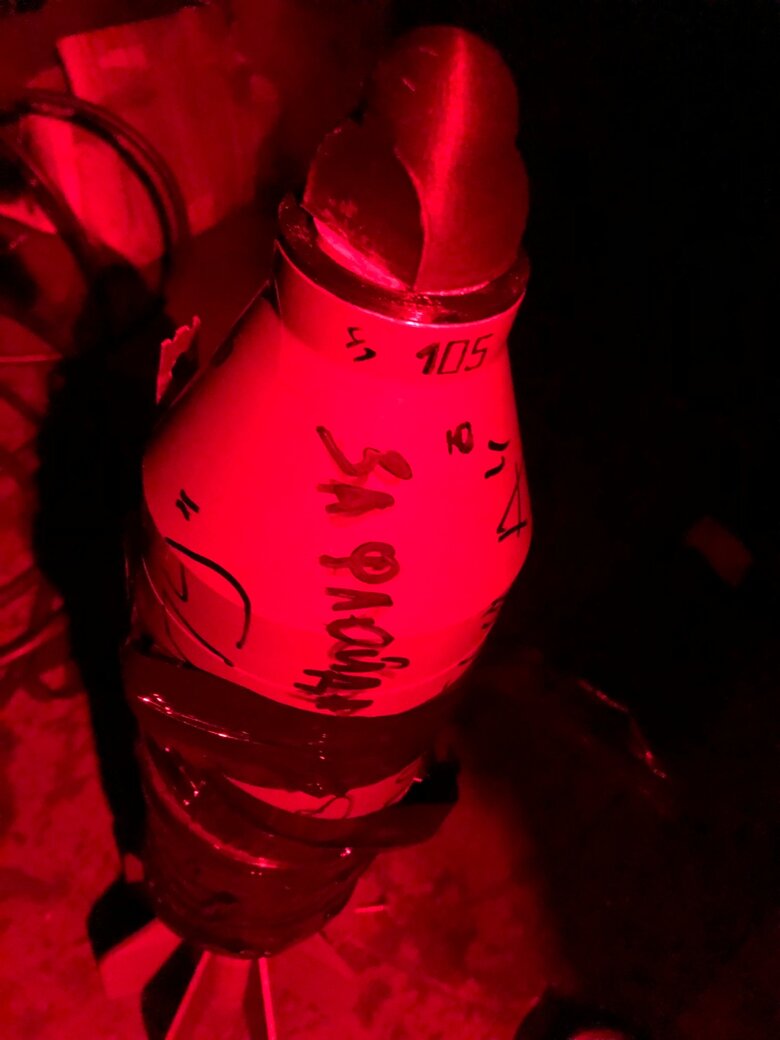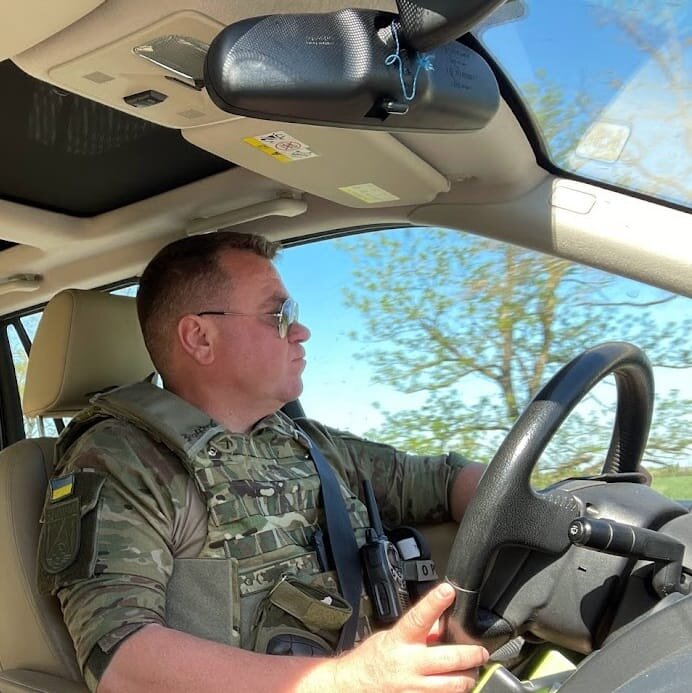UAV crew commander Serhii Khadzhynov: "Enemy was reporting: they were saying that their combat ammunition load depot was destroyed by high-precision weapons like Excalibur. But in reality, it was our aircraft made of foam and balsa!"
It seems that Serhii Khadzhynov cannot exist without technology. During the Revolution of Dignity, he was one of the prominent figures in the now legendary Automaidan. At the beginning of the full-scale revolution, he joined the air force as an aerial reconnaissance officer.
And now, as part of a crew of 5 comrades in arms (still called Automaidan) and a unique UAV named Postman, he is performing complex and interesting tasks for the command.
In this interview, Serhii talks about how Postman flies to the occupied territory with explosives, and not only, cargo. He also talks about how the enemy is trying to interfere with the work of Ukrainian unmanned systems. And also, at the request of Censor.NET, he discusses how to make the Ukrainian army more effective.
And we started with geography, which now determines the combat work of Khadzhynov's crew.
- You are garrisoned near Odesa, 80% of your work in combat positions is in the South, and the rest is in other locations across Ukraine. Is this true?
- That's right.
- In what entity are you now?
- I'm not sure if I can make this public, but I'll hint that we are in a well-known three-letter structure, but not a TCR (laughs - Ye.K.).
- I think our readers can guess what this well-known, yet secretive, structure is. Have these three obviously unpleasant letters for Russians added to your motivation and ambition in the tasks you perform?
- It added more. Because we have been provided with very interesting new tools, and we have much more opportunities than we had before. Plus, we are given very sexy tasks (smiles - Ye.K.).
- I am intrigued. But more about that later, and now about this. In the spring, you wrote an ironic post on Facebook, as usual, which contained the following paragraph: "The reformed patrol police are on the radar of the hunt, just like in the good old days. Solving the most important problem of the city, they sit in ambushes at all pre-war places, severely fining even 79 kilometres per hour. Even a military bus. Even with the military inside. Even if these soldiers are on their way to combat. And even if they are carrying a bomber aircraft in the bus". End of quote.
I understand your impressions of the reformed patrol police. But I'm more interested in the people they stopped. Do I understand correctly that you were talking about your crew?
- That's right.
- Then tell us what kind of bomber aircraft you were carrying in the bus. Does it have a name?
- Yes. It's called Postman. Because he delivers parcels, just like Nova Poshta. He delivers even to the enemy's territory - temporarily occupied and beyond. He can deliver 6-7 kilograms over a distance of 50 kilometres and return. So it's not a kamikaze. This is a bomber.
And the uniqueness is that our crew, I think, is probably the only aerial reconnaissance crew that produces these aircraft for itself. Not because of the good life - because we mastered this type of aircraft at the end of 2022 - but because circumstances dictate. - We lost one aircraft on a combat mission and then waited a long time to produce another. But in 3 months we studied the material, made our first aircraft and cancelled the order. At first, we copied what we had, and then improved it and went far ahead. Because we, as a combat crew, know exactly what works in combat conditions and what does not. And this is a completely different aircraft compared to the original. We make it from materials that are almost invisible to RS (radar system - Ye.K.). It is very quiet. It has a CRPA antenna and a high-quality GNSS module. That's why the enemy rarely manages to jam it, but if it does, the Postman will return using the so-called inertial (a built-in algorithm that calculates the aircraft's position without GPS).
- And who designed the original aircraft?
- Well, I can tell you a secret: it was a smuggler's plane that was used to transport cigarettes abroad. It was quite efficient! For example, to smuggle a box of cigarettes abroad, what do you have to do?
- I have no idea.
- You have to somehow attach wings, an engine, a controller, a tail to it so that it takes off with a lot of weight and flies silently and quietly, and drops it exactly where it's supposed to (where your smuggling partner is waiting on the other side). It is a very effective aircraft because, firstly, it is built around a munition (a box of cigarettes). Secondly, it is inexpensive compared to any military drone (not only military but also commercial drones of this size). And thirdly, it is resistant to damage. And even if something happens to it, it can be repaired very quickly in the field. There is no need to send it back to the manufacturer and wait.
That's how we copied our first aircraft. But then, as I said, we improved it significantly. We redesigned all the avionics. We changed the settings and significantly increased the range. As a result, it allows us to fly 50 kilometres, drop exactly 6 to 8 kilograms of parcel and return. It's not a kamikaze, but it costs less than a kamikaze. We believe that the more such aircraft we have, the better for all units of the Ukrainian Armed Forces. There is always a lot of work for it. So if someone needs one, we can make it. This is for advertising purposes (laughs - E.K.)
- You mentioned earlier the "sexual tasks" that your Postman performs. What could be sexy about that cargo?
- The sexiest thing is to fly through the hell out of EW and air defence, to fly with telemetry switched off. That is, the aircraft does not emit anything and the enemy cannot see it with ELINT (electronic intelligence). Drop it accurately, and the enemy does not understand what happened. Why, for example, the combat ammunition load depot or the house of the Russians placement exploded. When we later read the intercepts of their radio communications, they report a strike by a high-precision artillery shell of the Excalibur type or something like that. But it was actually our aircraft made of foam and balsa!
- You are not only dropping explosives on the enemy but also passing them on to our troops in the occupied territory, right?
- Of course, we do both. And explosives, and drops, and we transfer not only explosives but also other things. There are a lot of parcels that require constant sending to the other side. I am also impressed by the large number of our people on the TOT who risk their lives to receive our mail parcels. They are real heroes!
- Tell us about your working session, your combat mission. So you woke up. What's next?
- To begin with, we spend a significant percentage of our time training. That is, every day when the weather conditions are right, we go to the training ground and test something. We have a lot of things to test, improve and so on.
Since we work at night, depending on the daylight hours, we schedule our departure from our base at such a time that we arrive at the launch point at dusk. Then we prepare the launch, take off and work all night until dawn.
We return either to our base or to a temporary base. And we continue, if necessary, for the next few days or weeks until we have destroyed everything we need, all the targets we have marked.
- Many similarities with 2022...
- Not so much, because now the four of us are doing the work that in 2022 about 20 people did in a daylight hour.
- For example?
- For example, in the year 2022, an aerial reconnaissance crew like ours usually started working in the morning because there were no drones with night cameras. At first, we did reconnaissance, searched for targets, landed the drone, and brought the intelligence to the headquarters. Then, to make it faster, we negotiated with the artillery branch ourselves. Because this war is a real decision-making process (laughs - Ye.K.). If you don't have connections and you can't negotiate with someone who will destroy your target, there will most likely be no result. So we negotiated with the artillery branch directly. Then we waited until they agreed with their commander. Then we would take off again and start adjusting. The artillery would shoot. If they were lucky, the gun would hit the target on the second or third shot. If not, they could fire 10 shots in the air and then withdraw from the position. Because you can't stand in one place for long.
- That was the case before. And now?
- Now, thanks primarily to the Delta situational awareness system, which allows any commander to see where the enemy targets are in his area, we look at where they might be. Then we fly out our own reconnaissance drone with a very cool night camera. We find this target, observe it - and note that this drone does not land; it observes from a long distance. Then we launch the Postman, and it carries a 6-7 kilogram parcel to the target. And it usually hits the target the first time. So, all in all, if everything goes well, it can take a couple of hours. If not, it can take all night. But as a result, we do not depend on any external people to be engaged for destruction. We do everything ourselves.
- So you enjoy a certain degree of autonomy in your work?
- Yes and no. You see, this war, on the contrary, teaches you to cooperate with everyone as much as possible. If you cooperate, you have a much better chance of success.
On the other hand, our operations cannot always be reported. That's why we do it autonomously. But in general, to win, we need to have maximum cooperation within the Armed Forces.
So this is our plane. What does it do? It flies up to the target and measures the wind (which greatly affects the ballistic trajectory when we throw a munition, for example). And autonomously, without any pilot involvement, the aircraft enters the territory and calculates the drop point. And we have a very good chance, about 90%, that we hit the target the first time.
- Cool.
- This is how we work now. If you compare it to the year 2022, it's just fabulous.
- Apart from electronic warfare, how do the Russians try to shoot down our drones?
- They also have mobile air defence teams that are stationed in places that are important to them. And they have night vision devices. They have electronic intelligence that scans frequencies. If they see something moving at these frequencies at a certain azimuth, they give the mobile groups the direction from which the drone can fly. But there is one caveat.
- Which one?
- They are trained on our Baba Yaha drones, which drop from a height of 100 metres and do a lot of damage. So they expect a target that flies slowly and noisily. We are now flying much higher and quietly. Once we lost an aircraft, probably because of enemy fire at an altitude of 100 metres, but we are not one hundred per cent sure. It started raining and snowing suddenly when we took off, so maybe it was just the weather conditions.
- We're talking to you the morning after what is probably a record number of enemy UAV attacks in Ukraine: about 90 drones last night... For the average person, this attack had an unsettling emotional impact, but what did you think about it as a pro?
- What did I think about? That the enemy is trying to hit us in various ways. And I understand that they have already switched from ballistics, which used to be a serious threat to large cities, including Kyiv, to Shaheds. Because they understand that they can no longer do anything with ballistics thanks to our Patriots. So maybe this is even good news. And the fact that we already have mobile groups and other missile means of destroying the Shaheds around cities is good.
- But we generally believe that this number of UAVs, in addition to their situational tasks, is mainly aimed at depleting our air defence - so that their missile attacks have more success. To what extent are these nighttime UAV attacks - specific targets work, and to what extent is it a depletion of our air defense?
- If they wanted to deplete our air defence, they would have launched a combined attack. It would be Shaheds, cruise missiles, and ballistics. All at the same time. That's the worst thing that could happen.
- Let's go back to your profile. Let's imagine that Serhii Khadzhynov woke up and found out that he was now the President of Ukraine with all the powers of the Supreme Commander-in-Chief. What would be your three main decisions regarding the development of UAV forces?
- As for UAVs, I think everything is more or less fine. The fact that separate UAV forces have now been created and everyone understands their strategic importance is normal and very good. Drones have already become a decisive factor not only at the tactical level but also at the operational level. So everything is fine here, but since you have already asked the question, I would prefer to solve problems in the Armed Forces as a whole.
- Okay, what problems of the Armed Forces would President Khadzhynov solve?
- I see that the Armed Forces of Ukraine, unfortunately, are mostly a Soviet army. It has not been reformed, and this is a big problem. All the diseases that were in the Soviet army are also in the Armed Forces. Oh, how beautifully and correctly they said at the beginning of the war: "a small Soviet army will never defeat a big Soviet army," which is the Russian Armed Forces! That is why we need to turn into a small NATO army very, very quickly, with all the standards, approaches, procedures, management and, for example, openness of intelligence to all. Not the way it is now, for example, when we go to a new destination, it takes us at least a week to open the right layer in the Delta. Sometimes we fly without it. We have to write endless requests on paper to the head of the OTG or the OSGT and so on. There is a lot of paperwork, a lot of bureaucracy.
- As you can imagine, you are not the first to say this...
- ...We are now in the most developed and unregulated structure, but compared to civilian life, it's a nightmare. And if you look at the Armed Forces of Ukraine, look at what combat commanders do most of the time. Battle planning? No. They spend almost all their time writing something down in endless log books. They even have a log book of log books! And it's not a joke, it really exists - a log book of log book... So, at the very least, we need to transfer all this paper shit to some kind of application like "Action". It would be better to introduce a rule like this: whoever needs a piece of paper issues it. I assure you that it will suddenly become clear that no one needs most of the papers.
I also do not understand why do we have more generals and senior officers with unclear functions than sergeants?
Why do senior commanders have no responsibility? Why is it easier to promote an inept commander than to demote him? Why do they get rid of an idiot commander by sending him for training and then promoting him to the headquarters? This is a negative selection!
Why are the troops commanded by both the OC and the OSGT and the OTG? Where is the clear vertical here?
Why do we still fight in brigades, not divisions, like NATO?
- I hear this from the military for the umpteenth time...
- ...We need to implement this reform as soon as possible. In fact, I think it's not that difficult to do. This is not a reform of the courts, as the Automaidan was and is doing, where judges need to reform themselves, and in no case should anyone interfere. And what is the Armed Forces of Ukraine? It is a vertical. The Commander-in-Chief can simply give an order. He can just give it down and everyone from top to bottom will follow it. You must admit that this is much easier than other reforms.
- Now you say realistic, albeit sad, things. But on Facebook, you radiate optimism. And there it is possible to notice how treasonableness pisses you off". You like to have a good time on the adepts of treason in your posts.
But seriously, does the search for treason really prevent the country from countering the enemy?
- I don't mind when the treason is constructive and aimed at positive change, but it rarely happens. Usually, it is either hostile psyops or adult uncles and aunts who are dispersing it because they want someone to pat them on the head and dispel their fears, just like their mother did when they were children. This definitely does not help to fight.
Even the problems I have just mentioned do not affect the fact that we will definitely win in a strategic sense. Because we have the civilised world and its endless resources behind us. And civilisation has never lost a war to savages. And the question is whether we will accelerate our victory or fight for a long time. Any long war between more or less equal parties ends not because of a successful military operation or the loss of territory, but when one of the parties is simply unable to continue. Here is an example of the First World War. Kaiser's Germany signed the Treaty of Versailles, the surrender. Despite the fact that at the time of the signing, Germany had not given up a single hectare of its land. On the contrary, German troops were stationed in France and Belgium. They were on the enemy's territory - yet they signed this shameful peace. Why? Because they had exhausted their resources and had nothing to fight with. The blockade of ports, the economic crisis, hunger, political instability - and that's it, all the warlike fervour had disappeared.
My point is that Russia's resources will run out sooner or later, and it will definitely be sooner than our allies. Russia is already showing the first signs of economic exhaustion. Inflation is growing. The accounting rate is being raised. Our strategy now is to exhaust the enemy as much as possible by all means. And we are waiting for them to start doing what happened in Kaiser's Germany.
- Serhiy, tell me, where do you get this inexhaustible optimism from, against the backdrop of burnout (a buzzword) of many of us over the 2.5 years of this war? What do you see that many other people don't?
- I can tell you from my area. I think we have more than 500 drone manufacturers in Ukraine. Including our crew. And in Russia, there are only a few mostly state-owned mega-producers. Defeatists said that they had an advantage and that all was lost for us. It turned out to be the opposite. In almost a year, our competition has produced quality and quantity. As a result, unlike the enemy's Shaheds, our long-range kamikazes are already flying 1,800 kilometres to Olenya and using machine vision to hit the target. And we are already launching more long-range kamikazes at the enemy than the enemy is launching Shaheds at us. Our maritime drones achieved a strategic goal - we drove the Black Sea Fleet out of Crimea, the rest of which is now afraid to go to sea in Russia. The Pentagon is looking at this miracle in a stupor. Sometime at the end of 2022, the enemy showed the tsar its version of a naval kamikaze. And where is it?
And we are increasing our capabilities in various drones exponentially. And you ask where I get this optimism from (smiles - Ye.K.).
Please note!
Those wishing to help Serhii Khadzhynov's crew raise funds for the UAV components can donate here: https://www.privat24.ua/send/cva4n
5168752101009648
www.privat24.ua
Yevhen Kuzmenko, Censor.NET
PHOTO: from the archive of Serhii Khadzhynov and his crewmates







